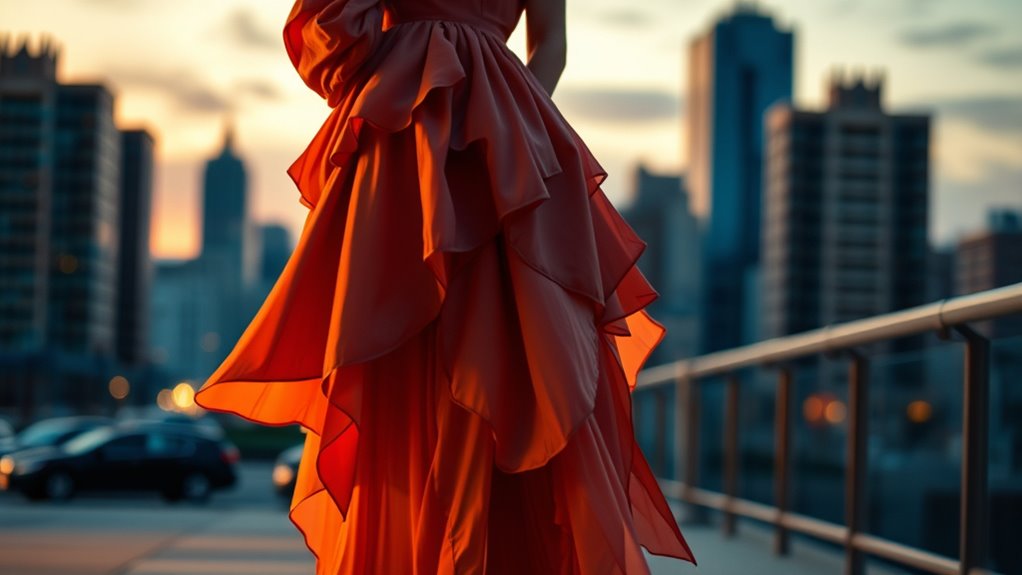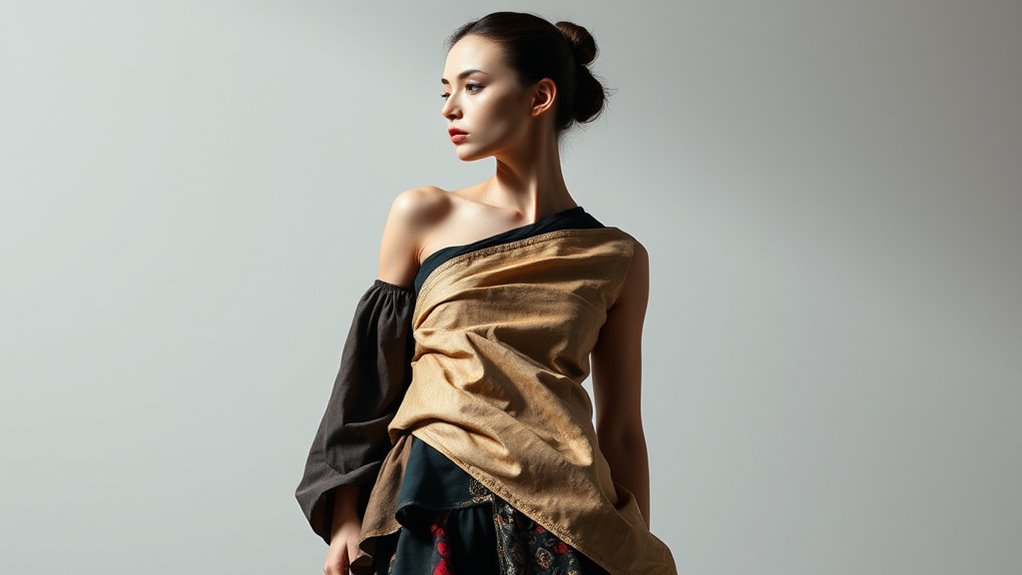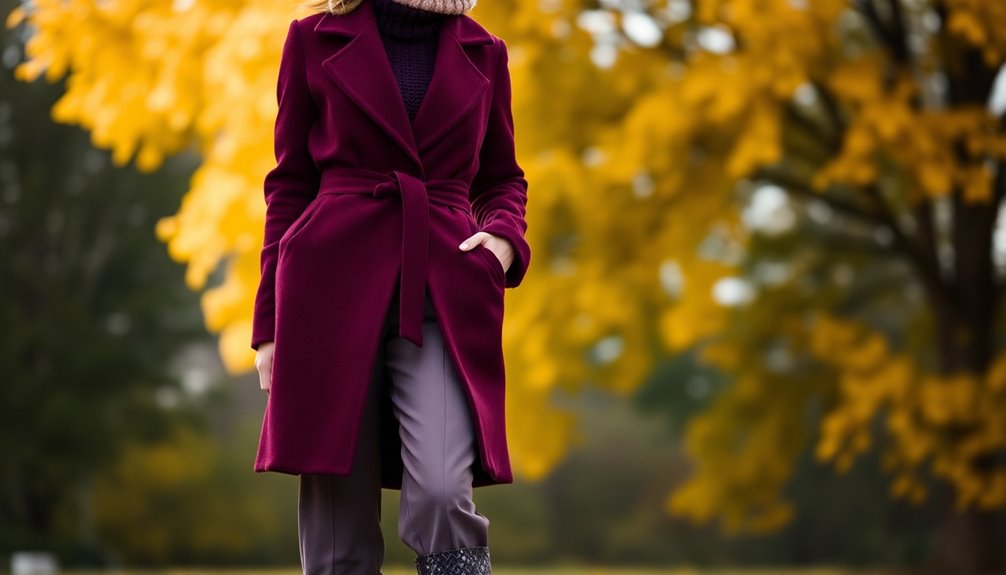Embracing asymmetry in your style lets you create bold, personalized looks that stand out. You don’t have to mirror objects perfectly—instead, balance bold elements with subtler details to keep your outfit visually interesting and harmonious. Use this approach to express personality and modern flair while avoiding chaos. Mastering the art of visual weight and intentional imbalance can elevate your outfits, so if you want to explore more ways to style uneven silhouettes, keep exploring further.
Key Takeaways
- Embrace asymmetry intentionally by balancing bold, uneven elements with subtle pieces to create visual harmony.
- Use visual weight strategically to guide the eye and maintain cohesion in asymmetric silhouettes.
- Balance asymmetric features with negative space or simple accessories to prevent overwhelming the overall look.
- Incorporate contrasting textures and patterns to add interest while keeping the ensemble balanced.
- Master the principles of balance and proportion to confidently style dynamic, asymmetrical outfits.

Have you ever noticed how asymmetry shapes every aspect of our world, from nature to technology? It’s a fundamental aspect that influences how we perceive beauty, stability, and interest. In styling an uneven silhouette, understanding the balance principles can help you create visually engaging outfits that feel intentional rather than chaotic. Balance principles involve distributing visual weight in a way that keeps the eye moving comfortably across the ensemble. When working with asymmetrical designs, you don’t need everything to be perfectly mirrored; instead, you aim for a sense of equilibrium that feels natural and dynamic. This means that if one side of your outfit features a voluminous sleeve or bold accessory, the other side should balance it with a subtler element. This careful consideration ensures that the visual weight isn’t uneven or overwhelming, but instead complements the overall look.
Visual weight is a key concept here. It refers to how the eye perceives different parts of your outfit — some elements draw more attention than others. When styling asymmetrical pieces, you want to consciously manipulate visual weight so that your outfit remains cohesive and harmonious. For example, a striking asymmetric top with bold patterns or textures will naturally draw the eye. To balance this, you might opt for a sleek, simple bottom or minimal accessories on the other side. The goal is to create a visual flow, guiding the observer’s gaze smoothly across your silhouette without feeling disjointed. Recognizing how cheating can distort perception reminds us of the importance of intentional design choices to maintain harmony. Incorporating awareness of energetic alignment can further enhance how your outfit expresses your personal energy and confidence. Additionally, embracing space utilization allows you to balance asymmetry with negative space, preventing your look from feeling cluttered or uneven. Being mindful of proportion is also essential to ensure each element contributes to a balanced silhouette. Understanding how costume accessories can influence overall balance is also crucial when styling bold or themed outfits.
Incorporating asymmetry into your style isn’t about randomness; it’s about purposeful design. By applying balance principles, you can craft outfits that are lively and interesting without sacrificing harmony. Think of asymmetry as a way to add personality and modern edge, breaking away from traditional symmetry that can sometimes feel stagnant. When you understand how to manipulate visual weight, you can confidently wear uneven silhouettes that command attention and express your unique sense of style. Asymmetry, when executed thoughtfully, becomes a powerful tool to challenge conventional aesthetics, making your look feel fresh, dynamic, and full of character. So next time you choose an asymmetrical piece, remember: balancing visual weight and applying balance principles will help you achieve a striking, well-composed ensemble.
Frequently Asked Questions
How Can Asymmetrical Clothing Suit Different Body Types?
You can make asymmetrical clothing work for your body by using balance techniques. For example, if you have broader shoulders, choose asymmetrical tops that draw attention downward or to your waist. Style tips include pairing asymmetrical pieces with fitted bottoms to create harmony. Remember, the key is to highlight your best features while maintaining visual balance, so experiment with different shapes and asymmetry to find what flatters your unique silhouette.
What Accessories Best Complement Asymmetrical Designs?
Your accessories can make or break an asymmetrical look—it’s like wielding artistic power! Opt for statement jewelry to draw attention to unique lines and shapes, adding a touch of drama. Pair this with bold handbags to balance the visual interest and enhance the asymmetry’s edgy appeal. These accessories don’t just complement; they amplify your style, turning an uneven silhouette into a fierce fashion statement that’s impossible to ignore.
Are There Specific Fabrics That Work Better With Asymmetry?
When choosing fabrics for asymmetrical designs, you should consider fabric textures and garment constructions that enhance the look. Lightweight, fluid fabrics like silk or chiffon work well, adding softness to irregular shapes. Sturdier materials like denim or neoprene give structure and define the silhouette. Fabrics with interesting textures, such as ribbed or embroidered textiles, also complement asymmetry by adding visual interest and emphasizing the unique garment construction.
How Can Asymmetrical Fashion Be Incorporated Into Formal Wear?
Think of asymmetrical fashion as a dance on the edge of balance and chaos. You can incorporate it into formal wear by choosing pieces that follow balance principles, like an uneven hemline paired with a fitted top. Use color harmony to keep the look cohesive, and opt for sleek accessories to anchor the outfit. This way, your style remains elegant yet daring, making a statement that’s both refined and uniquely you.
What Historical Fashion Movements Influenced Asymmetrical Styles?
You’ll notice that historical fashion movements like the Renaissance with its ruffles and the Art Nouveau emphasis on curves heavily influenced asymmetrical styles. These eras embraced irregular lines and decorative details, inspiring designers to incorporate uneven silhouettes into modern fashion. By studying these movements, you can see how they challenged symmetry and celebrated natural, flowing forms, giving your personal style a touch of historic elegance and artistic flair.
Conclusion
Embrace the beauty of asymmetry, for it’s the brushstroke that turns a blank canvas into a masterpiece. Like the unpredictable dance of waves or the jagged edge of a mountain peak, uneven silhouettes remind us that perfection isn’t the goal—authenticity is. When you wear asymmetry, you invite a sense of wild, unbridled freedom into your style. Remember, even the stars shine brightest in their irregular brilliance, inspiring you to celebrate your unique, beautiful imperfections.









